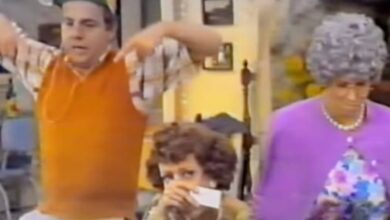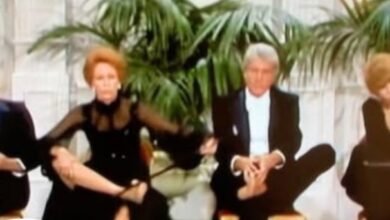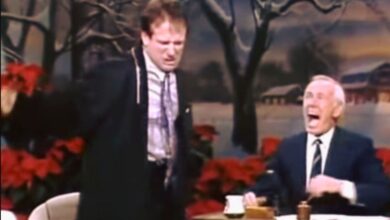George Jones & Tammy Wynette’s “Golden Ring” Tops Country Charts in 1976 and Redefines the Power of the Story-Song Duet
In the summer of 1976, “Golden Ring” burst onto American radio like the glint of a wedding band catching sunlight, instantly capturing listeners with its poignant tale of love found, lost, and remembered. Issued as the title track of George Jones and Tammy Wynette’s second duet album after their divorce, the single felt daring—almost voyeuristic—because it exposed private heartbreak while ascending to public triumph. Its quick climb to No. 1 on Billboard’s Hot Country Singles chart proved that country audiences were ready for songs that combined soap-opera intimacy with chart-shaking hooks, and that the pair’s chemistry remained magnetic even after matrimony had ended.
George Jones, born in the piney woods outside Saratoga, Texas, had already earned the nickname “Possum” for his sharp features and even sharper honky-tonk instincts by the mid-1960s. Tammy Wynette, raised on a Mississippi cotton farm and first known as Virginia Wynette Pugh, brought an unmistakable mix of vulnerability and power to her vocal phrasing—qualities that would soon crown her the “First Lady of Country Music.” When they first cut duets in 1969, their contrasting backgrounds fused into something undeniably electric: Jones’s drawling baritone curled around Wynette’s soaring soprano like rough bark around a delicate blossom, offering a male-female dynamic that transcended the genre’s usual gender lines.
The seed for “Golden Ring” sprouted in the minds of writers Bobby Braddock and Rafe Van Hoy, who were fascinated by the idea of tracking a humble wedding band through the full cycle of a relationship. Braddock, famous for his knack for narrative twists, reportedly drew inspiration from a newspaper article about a pawned ring, while the 19-year-old Van Hoy sketched lyrical vignettes that would mirror an entire marriage in three short verses. Legend holds that when Jones and Wynette heard the demo separately, each recognized their own broken union in the song’s bittersweet arc—making the decision to record it together feel at once cathartic and commercially shrewd.
Producer Billy Sherrill, architect of the “countrypolitan” sound, gathered Nashville’s A-team session players at Columbia Studio B in January 1976. He framed the track with gentle, almost hymn-like piano chords from Hargus “Pig” Robbins, a lilting steel-guitar obbligato by Pete Drake, and a string section mixed low enough to enhance emotion without smothering it. Jones and Wynette tracked their vocals facing each other in the booth, eyes reportedly locked as they traded lines—an approach Sherrill encouraged to stoke real-time chemistry. The resulting take captured raw tremors in Jones’s phrasing and a catch in Wynette’s final high note that sounded less performed than lived.
Radio stations scented a hit the moment the single shipped in May. Within eight weeks it sat atop the country chart, staying there for a fortnight and lingering in the Top 40 for nearly four months. Trade magazines praised its “cinematic storytelling,” and fans flocked to stores for the accompanying album, propelling it into the Top 5. Although it never crossed to pop radio, “Golden Ring” did breach Adult Contemporary playlists in several major markets, hinting that emotionally charged narratives could bridge format divides even without heavy crossover promotion.
Culturally, the song landed at a crucial moment when divorce rates were climbing and the notion of “happily ever after” seemed increasingly fragile. By chronicling a couple’s joy, unraveling, and nostalgic afterglow through the travels of a single object, Jones and Wynette reframed heartbreak as a universal rite of passage rather than a private failure. Critics credited the track with pushing country music further toward sophisticated storytelling—closer to short-form cinema than three-chord lament—and audiences responded by treating it almost like an audio novella, dissecting each verse for clues about the singers’ real-life split.
Career-wise, the single reopened doors that had begun to close for the duo. Their joint tour schedule, uncertain after the dissolution of their marriage, suddenly ballooned: promoters booked them into civic centers from Tulsa to Toronto, banking on the public’s fascination with seeing ex-spouses harmonize about ruined love each night. Television appearances on “Hee Haw” and the “Jerry Lewis MDA Telethon” further expanded their reach, and the album’s success persuaded Epic Records to green-light additional duet projects well into the 1980s—unthinkable months earlier when their future as a brand looked dim.
Within the genre, “Golden Ring” became a template for narrative duets that functioned like mini-movies. Its influence surfaced in Conway Twitty and Loretta Lynn’s “The Letter,” the Judds’ “Grandpa (Tell Me ’Bout the Good Old Days),” and later in Garth Brooks and Trisha Yearwood’s dramatic pairings. Even outside country, pop acts such as Kenny Rogers & Sheena Easton cited the Jones-Wynette chemistry when crafting story songs tailor-made for male-female dialogue. The track’s structure—object as narrator, shifting emotional tones across verses—would echo in countless releases over the next two decades.
Several artists attempted to capture its magic through covers. Jason Sellers and Pam Tillis recorded a respectful rendition in 1997, leaning into a ’90s neo-traditional arrangement that returned steel guitar to prominence. More recently, indie folk duo The Civil Wars performed the song in concert, stripping it to two voices and a single acoustic guitar, emphasizing lyrical resonance over production polish. Each new interpretation underscored the song’s elastic relevance: whether draped in strings or reduced to campfire intimacy, its core story remained hauntingly vivid.
At the time of the single’s ascent, both singers were navigating turbulent personal chapters. Jones struggled with alcohol-related no-shows, while Wynette endured health issues that would require multiple hospitalizations. Yet the song’s success briefly eclipsed those troubles, casting them in a heroic light as two artists who could still summon brilliance amid chaos. The narrative also fueled tabloid speculation of a reconciliation—rumors they publicly denied but privately acknowledged helped ticket sales.
Decades on, “Golden Ring” maintains heavy rotation on classic-country stations and routinely places high on lists of the greatest duets ever recorded. The RIAA certified it gold in the early ’90s when catalog sales surged, and CMT’s 2004 countdown ranked it among the top ten country love songs—an irony, given its depiction of love’s demise. For new listeners raised on streaming playlists, the track often serves as an entry point to both artists’ deeper catalogs, illustrating how a well-told story can outlive shifting production tastes.
The song also nudged Nashville producers toward more cinematic soundscapes. Sherrill’s use of strings without sacrificing traditional instrumentation became a blueprint for subsequent ballads aiming for crossover sheen. Moreover, the conversational vocal trade-offs between Jones and Wynette inspired duet partners to craft songs as dialogues rather than mere harmony showcases, a trend audible in later hits from Brooks & Dunn to Sugarland.
When Tammy Wynette passed away in 1998, “Golden Ring” resurfaced in tribute specials, its story of impermanence tinged with new poignancy. Jones’s death in 2013 prompted another wave of retrospectives, many of which featured the song as the emotional centerpiece, framing it as a testament to artistic alchemy transcending personal fault lines. Inductions into the Country Music Hall of Fame for both singers cited the track among their definitive accomplishments.
Ultimately, what keeps “Golden Ring” gleaming nearly fifty years later is its seamless fusion of narrative clarity, vocal chemistry, and emotional candor. It invites listeners to trace their own arcs of love and loss onto the circular symbol at its heart, reminding us that even when relationships fracture, the stories—and the songs—can endure, passing from hand to hand like heirlooms of shared experience. In chronicling one tiny band of gold, George Jones and Tammy Wynette etched a timeless portrait of the human condition, proving that the most personal tales often resonate the loudest across generations and genres alike.





